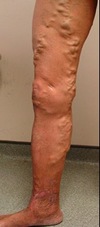Vascular Flashcards
Name 5 things to look for on general inspection in a vascular exam.
- Smoking
- Inhalers
- Diabetic medication
- AV fistula
- Dressings
- Walking stick
- Weight: thin (indicating smoking) OR fat (high cholesterol)
- False leg/amputations
- Hands: nicotine stains, splinters, missing fingers
What does the supra-aortic pulse examination include?
- Radial pulse: rate (tachycardia or not), rhythm, radio-radial delay
- Brachial- character
- BP- normotensive vs hypertensive
- Subclavian pulse- bruits
- Carotid pulse- bruits
What does radio-radial delay indicate?
Obstruction of the aorta or one of the vessels branching off. Most common in type A aortic dissection.
What does the abdominal vascular examination involve?
- Expose (including groin)
- Look at abdomen: scars (e.g. ilio-femoral bypass graft)
- Palpate: AAA with one hand first to see if PULSATILE, then both hands to see if expansile
- Auscultation: bruits of aorta, renal

What does the lower limbs vascular examination involve?
- Inspect including colour
- Feel temperature: start with toes, between toes and heels
- Femoral arteries: feel simultaenously as a weak femoral pulse is difficult to determine. Radio-femoral delay
- Popliteal arteries: check if expansile
- Dorsalis pedis (continuation of anterior tibial artery) and posterior tibial pulse
- Auscultate: bruits in iliac, CFA, adductor hiatus- may only hear after exercise
- Buerger’s Angler, Buerger’s Test

What is a dominant peroneal artery?
Anatomical variance present in 5% of the population, there is absent dorsalis pedis pulse on exam but a pulse just anterior to the lateral mallelous as the foot is supplied by branches of the peroneal vessel.
What is a persistent sciatic artery?
Rare anatomical variance characterised by a persistent sciatic arterial supply to the lower limb and absence of femoral vessels. May present with pain, pulsatile buttock or ischaemia of the leg.

How do you measure Buerger’s Angle and perform Bueger’s test?
- Raise both feet and hold them up, the angle above the bed that the foot goes white is Bueger’s angle.
- When foot blanches, let the legs hang over the side of the bed
- The ischaemic foot will go brick red- indicating significant arterial disease of the lower limb.
- Goes red due to nitric oxide and toxins
How do you calculate the ankle brachial pressure index?
- Measure blood pressure in the arm required to collapse artery
- Measure pressure in the ankle required to collapse the artery
- This pressure is measured using Doppler
- Divide arm pressure by ankle pressure
What do the following ABPIs indicate?
- 0.8-1.0
- 0.6-0.8
- <0.6
- Normal
- Claudicatin
- Critical ischaemia
What are the 2 reasons why diabetics may have an abnormally raised ABPI?
- Calcification so can’t overcome intra-arterial pressure
- Distal disease with palpable pulse but NECROSIS from more peripheral disease
What do the scars in this picture allow access to for vascular surgery?

- Rooftop scar: aorta above the kidneys
- Midline scar: abdominal aorta access, if you extend this diagonally upwards to the 6th intercostal space you can repair thoraco-aortic aneurysms which are common in Marfan’s patients.
- Rutherford-Morrison scar: iliac artery
- Groin scars: common femoral arteries

What do the following scars suggest?
- Left: Neck scar
- Left: Two groin scars
- Right: 3 scars together

- Carotid endarterectomy: stroke, mini-stroke, amarosis fugax with 70% carotid artery stenosis.
- Femoro-femoral bypass graft
- Axillo-bifemoral bypass graft- usually for occlusion
Why would a patient have a graft?
How would you know it’s working clinically?
- Trauma, aneurysm or occlusion
- If pulse is present at bottom of graft then it’s probably working
What are two types of graft that could be used?
- Artificial- e.g. PTFE (polytetrafluoroethylene), Dacron
- Autologous- e.g. use of long saphenous vein
Two methods by which long saphenous vein can be used as a graft in treating femoral/popliteal/tibial artery stenosis? Which do you feel a pulse in?
- Valvotomy (removal of valves) of long saphenous vein. Would feel pulse as it’s reattached superficially.
- Excision and reversal of the long saphenous vein. Would not feel pulse as reattached deep within leg.
Why are PTFE/Dacron grafts not used in the leg as commonly as autologous grafts? (3)
- Higher thrombosis rate
- Lower longevity
- Higher risk of infection
What would the scars in this image suggest?

- Long saphenous vein graft (left image right leg)
- Femoral-popliteal bypass graft (left image left leg)
- Infra popliteal bypass graft (right image)
What causes pain in claudication?
Stenosis of an artery prevents enough oxygenated blood from reaching tissue on exertion. Get lactic acid build up leading to cramp.
3 investigations for claudication?
- Exercise treadmill ABPIs
- Duplex scan (BMO ultrasound to visualize artery followed by multidirectional Doppler to identify portion of artery affected)
- Angiography (allows detailed picture of arterial system)










